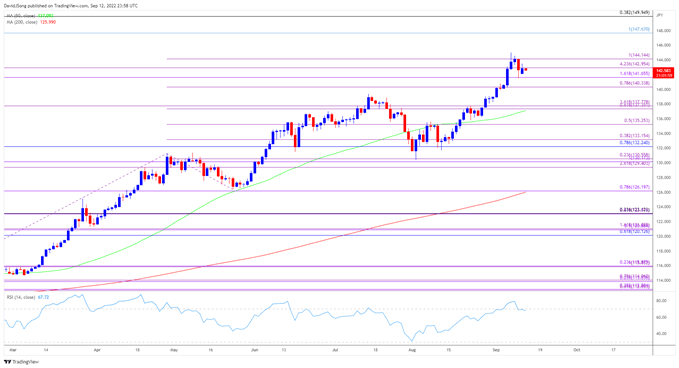Japanese Yen Talking PointsUSD/JPY appears to be defending the opening range for September as it attempts to retrace the decline from the monthly hig
Japanese Yen Talking Points
USD/JPY appears to be defending the opening range for September as it attempts to retrace the decline from the monthly high (144.99), but recent developments in the Relative Strength Index (RSI) raises the scope for a larger pullback in the exchange rate as the oscillator falls back from overbought territory to indicate a textbook sell signal.
USD/JPY Susceptible to Larger Pullback as RSI Sell Signal Emerges
USD/JPY consolidates after snapping the series of higher highs and lows from last week, with the move below 70 in the RSI likely to be accompanied by a larger pullback in the exchange rate like the price action earlier this year.

As a result, USD/JPY may continue to give back the advance from the monthly low (138.84) despite the ongoing rise in US Treasury yields, and it remains to be seen if the update to the US Consumer Price Index (CPI) will influence the exchange rate as the core reading for inflation is expected to widen to 6.1% in August from 5.9% per annum the month prior.
Indications of stick price growth may generate a bullish reaction in USD/JPY as it puts pressure on the Federal Reserve to retain its current approach in combating inflation, and the recent weakness in the exchange rate may turn out to be a correction in the broader trend as the Bank of Japan (BoJ) remains reluctant to move away from its easing cycle.
In turn, speculation for another 75bp rate hike may keep USD/JPY afloat as the Federal Open Market Committee (FOMC) plans to carry out a restrictive policy, while the tilt in retail sentiment looks poised to persist as traders have been net-short the pair for most of the year.

The IG Client Sentiment report shows 24.94% of traders are currently net-long USD/JPY, with the ratio of traders short to long standing at 3.01 to 1.
The number of traders net-long is 16.55% higher than yesterday and 1.24% higher from last week, while the number of traders net-short is 3.57% higher than yesterday and 0.45% lower from last week. The rise in net-long interest has helped to alleviate the crowding behavior as only 21.58% of traders were net-long USD/JPY last week, while the decline in net-short position comes as the exchange rate snaps the series of higher highs and lows from last week.
With that said, recent developments in the Relative Strength Index (RSI) raises the scope for a larger pullback in USD/JPY as the oscillator falls back from overbought territory to indicate a textbook sell signal, but the exchange rate may continue to track the positive slope in the 50-Day SMA (137.10) amid the diverging paths between the FOMC and BoJ.
Recommended by David Song
Learn More About the IG Client Sentiment Report
USD/JPY Rate Daily Chart

Source: Trading View
- USD/JPY gives back the advance from the start of the month amid the failed attempts to close above the 144.10 (100% expansion) region, and the bullish momentum may continue to abate as the Relative Strength Index (RSI) falls back from overbought territory to indicate a textbook sell signal.
- The move below 70 in the RSI is likely to be accompanied by further pullback in USD/JPY like the behavior seen earlier this year, with a close below 141.70 (161.8% expansion) bringing the 140.30 (78.6% expansion) region back on the radar.
- Failure to defend the monthly low (138.84) may push USD/JPY back towards the 137.40 (61.8% expansion) to 137.80 (316.8% expansion) region, but the exchange rate may continue to track the positive slope in the 50-Day SMA (137.10) if it manages to hold above the moving average.
Recommended by David Song
Traits of Successful Traders
— Written by David Song, Currency Strategist
Follow me on Twitter at @DavidJSong
element inside the
element. This is probably not what you meant to do!Load your application’s JavaScript bundle inside the element instead.
www.dailyfx.com
